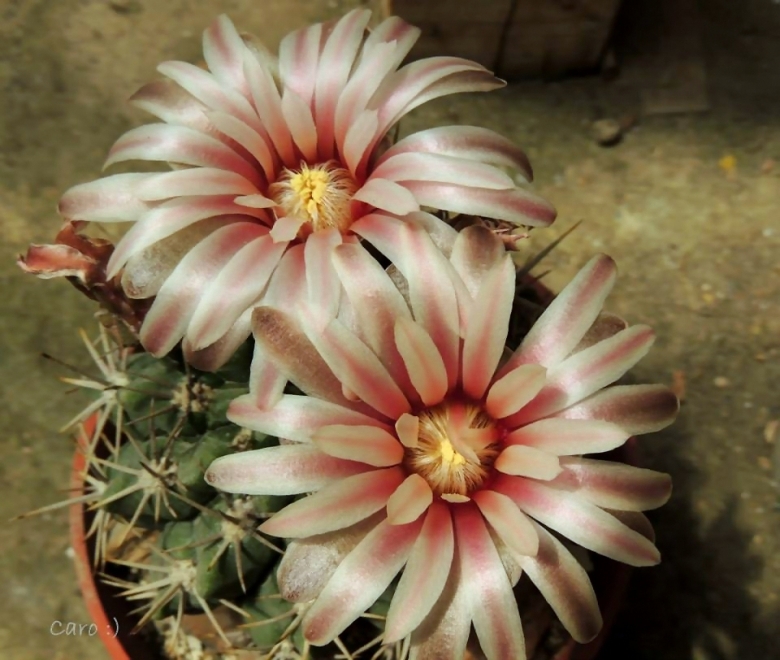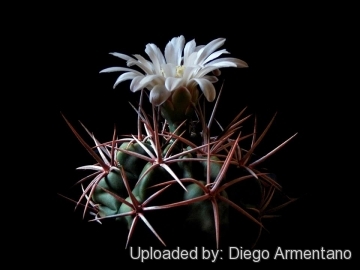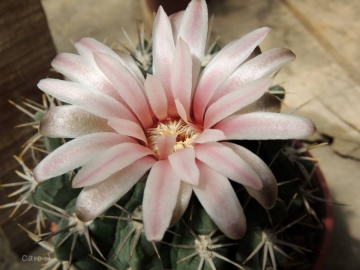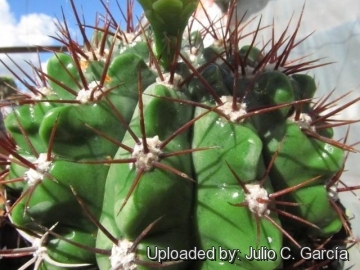Accepted Scientific Name: Gymnocalycium mostii (Gürke) Britton & Rose
Addisonia 3: 5, pl. 83. 1918

Echinocactus mostii (Gymnocalycium mostii) Photo by: Carolina González
Origin and Habitat: Gymnocalycium mostiiSN|11465]]SN|11465]] has a wide range, in Argentina (Córdoba).
Altitude range: 500 to 1,500 metres above sea level.
Habitat and Ecology: This cactus species grows on outcrops in chaco forest, and in grasslands. The species is extremely abundant and there are no major threats, the species is locally collected but this does not affect the population.
Synonyms:
See all synonyms of Gymnocalycium mostii
back
Accepted name in llifle Database:Gymnocalycium mostii (Gürke) Britton & RoseAddisonia 3: 5, pl. 83. 1918Synonymy: 21
back
Common Names include:
ENGLISH: Most's Gymnocalycium
Description: Gymnocalycium mostiiSN|11465]]SN|11465]] is a solitary cactus species with a flattened dark green stem usually less than 13 across. The ribs are broad and obtuse with a small sharp chin below each tubercle. The horn-coloured spines take a nice red colouring when wetted. Its pale rose-pink blooms are profusely produced during the growing season.
Derivation of specific namae: The specific epithet honours the plant collector Carlos Most, who collected in Argentina.
Stem: Depressed-globose, 6 to 7 cm high, 13 cm in diameter, dark to bluish green.
Ribs: 11 to 14, vertical or slightly spiralled with age, broad and obtuse, deeply notched, with prominent, well defined tubercles.
Areoles: Roundish or elliptical, 6-8 mm long, with creamy-white wool when young, almost bare as they ages.
Spines: Strong, subulate, yellowish-brown or horn-coloured, darker brown and glossy at base and tips, becoming grey with age, stout, curving toward the stems; radial spines 7 to 9(-11), unequal, 6 to 22 mm. long; central spine solitary (occasionally 2), 18 to 20 mm Long.
Flower: Campanulate, rose pink, 6 to 8 cm broad. Tube short and thick, shining bluish green, with 8 to 10, semicircular, pale edged scales. Perianth-segments spreading pale rose pink with darker base, oblong.
Fruits: Ovoid to almost spherical, slate blue-green, to 2 cm long and 1.5 cm in diameter.
Seeds: Roundish, 0.7-0.9 mm, dark-reddish-brown to black, matt, with whitish hilum.
Bibliography: Major references and further lectures
1) N. L. Britton, J. N. Rose “The Cactaceae. Descriptions and Illustrations of Plants of the Cactus Family.” Volume 3, The Carnegie Institution of Washington, Washington 1922
2) Edward Anderson “The Cactus family” Timber Press, Incorporated, 2001
3) David R Hunt; Nigel P Taylor; Graham Charles; International Cactaceae Systematics Group. "The New Cactus Lexicon" dh books, 2006
4) Curt Backeberg “Die Cactaceae: Handbuch der Kakteenkunde” Gustav Fischer Verlag, Stuttgart New York 1982–1985
5) James Cullen, Sabina G. Knees, H. Suzanne Cubey "The European Garden Flora Flowering Plants: A Manual for the Identification of Plants Cultivated in Europe, Both Out-of-Doors and Under Glass" Cambridge University Press, 11/Aug/2011
6) Demaio, P. & Trevisson, M. 2013. Gymnocalycium mostii. The IUCN Red List of Threatened Species. Version 2014.3. <www.iucnredlist.org>. Downloaded on 14 March 2015.
7) Schumann & Guerke, “Blühende Kakteen” 2: pl. 93 1907
8) Leonard E. Newton “Etymological Dictionary of Succulent Plant Names” Birkhäuser page 158. 2004
 Echinocactus mostii (Gymnocalycium mostii) Photo by: Diego Armentano
Echinocactus mostii (Gymnocalycium mostii) Photo by: Diego Armentano Echinocactus mostii (Gymnocalycium mostii) Photo by: Carolina González
Echinocactus mostii (Gymnocalycium mostii) Photo by: Carolina González - Wet spines take a nice red colour. (Gymnocalycium mostii) Photo by: Julio C. García
- Wet spines take a nice red colour. (Gymnocalycium mostii) Photo by: Julio C. García Echinocactus mostii (Gymnocalycium mostii) Photo by: Diego Armentano
Echinocactus mostii (Gymnocalycium mostii) Photo by: Diego Armentano Field number JPR 92-112/267 (Collector Jaroslav Procházka) Agua de Oro, Cordoba, Argentina. (Gymnocalycium mostii) Photo by: Valentino Vallicelli
Field number JPR 92-112/267 (Collector Jaroslav Procházka) Agua de Oro, Cordoba, Argentina. (Gymnocalycium mostii) Photo by: Valentino VallicelliSend a photo of this plant.The gallery now contains thousands of pictures, however it is possible to do even more. We are, of course, seeking photos of species not yet shown in the gallery but not only that, we are also looking for better pictures than those already present.
Read More... Cultivation and Propagation: Gymnocalycium mostiiSN|11465]]SN|11465]] is a summer grower species that offers no cultivation difficulties. Water regularly in summer ( but can handle excessive water to few water) Keep this plant almost dry in winter at a minimum temperature of 0°C, prefer relatively rich substrate and low pH compost (if possible not limestone) otherwise growth will stop altogether. Feed with a high potassium fertilizer in summer. It is quite frost resistant if kept dry (Hardy to -12C). This plant needs plenty of space for its roots, repotting should be done every other year or when the it has outgrown its pot. This species is particularly easy and accommodating, seldom suffer of cryptogamic diseases.
Sun Exposure: Light shade. It may tolerate bright situations but is likely to suffer from sun scorch or stunted growth if over exposed to direct sunlight during the hottest part of the day in summer.
Propagation: Direct sow after last frost. (seldom produces offsets)
Seed Collecting: Permit fruit to ripen. Fruit must be significantly overripe before harvesting seed; clean and dry seeds.















